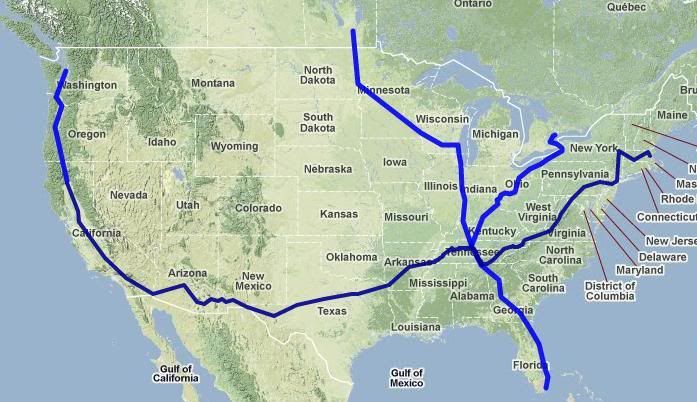(10 am. – promoted by ek hornbeck)
Burning the Midnight Oil for Living Energy Independence
 “Why We Fight” is a common feature of propaganda in support of a war. Here, tonight, it is a double entendre. On tonight’s Sunday Train, in honor of Memorial Day tomorrow, with two wars launched in the past decade and still ongoing (though in one, “combat operations” by US forces have finished, so any fighting and dying is of the support and training type of fighting and dying), and another recently started up, what it means when we notice that “why we fight” has a simple answer: oil.
“Why We Fight” is a common feature of propaganda in support of a war. Here, tonight, it is a double entendre. On tonight’s Sunday Train, in honor of Memorial Day tomorrow, with two wars launched in the past decade and still ongoing (though in one, “combat operations” by US forces have finished, so any fighting and dying is of the support and training type of fighting and dying), and another recently started up, what it means when we notice that “why we fight” has a simple answer: oil.
And also, politically, why we fight for Living Energy Independence, here on the Sunday Train.
Is There Any Doubt We Fight For Oil?
 There really isn’t any doubt we fight for oil, is there? In Afghanistan, we invaded because they were harboring Osama bin Laden and Al Qaeda, who had just masterminded a massive terrorist attack. Osama bin Laden was pissed off at the US for having an army composed mostly of infidels in Saudi Arabia, “Guardian of the Holy Places”, two of the three holiest sites in Islam.
There really isn’t any doubt we fight for oil, is there? In Afghanistan, we invaded because they were harboring Osama bin Laden and Al Qaeda, who had just masterminded a massive terrorist attack. Osama bin Laden was pissed off at the US for having an army composed mostly of infidels in Saudi Arabia, “Guardian of the Holy Places”, two of the three holiest sites in Islam.
And our army was there in Saudi Arabia because of oil.
As for Iraq, clearly we weren’t there for weapons of mass destruction. So we were either there to try to get an inside track on their oil reserves, or else to get back at Saddam for spoiling Daddy Bush’s Gulf War I victory.
But Gulf War I was fought because Saddam had his army invade Kuwait, and we counter-invaded because Kuwait had a lot of oil and the invasion made a lot of other Gulf Oil Nations very nervous about what would happen to them if the precedent stood.
And, indeed, even if we counter-invaded because that’s what we always do when an authoritarian monarchical state is invaded by an authoritarian fascist state somewhere around the world (stay with me here, I said even if) … Saddam invaded because Kuwait had oil.
So one way or another, that was because of oil. Arguing which oil-based reason it was is just quibbling.
And clearly, what sets Libya apart from the other “Arab Spring” countries is that they are an important European oil supplier, and Ol’ Mo is not trusted as a reliable manager of those oil supplies, so we could get quite a number of NATO allies to say, “oh, yeah, definitely” when we rang around to see if anything should be done about Ol’ Mo threatening to massacre thousands to hundreds of thousands of his people.
Seriously, if all it took was thousands to hundreds of thousands threatened with being massacred, we’d have multiple divisions spread across central and east Africa right now.
Who’s “WE” here?
My first degree was a B.Phil in Interdisciplinary Studies with a specialization in Latin American Studies. And so from the 1980’s, I’ve had some appreciation for what happens when the armed forces start making policy ~ which is to say, things go downhill from there pretty quickly.
So I am not going to go down the track of wondering whether members of the armed forces ought to respond to the call to fight for oil. I’m sticking with the burden on that question being with those who make the call.
And as long as we stay addicted to oil, The Powers That Be (TPTB) will keep on making that call. If we care about the men and women who wear this nation’s uniform, and do not want them to have to answer the call to go to war for oil ~ its up to us to find ways to kick the addiction.
But ~ why High Speed Rail?
 Why Living Energy Independence?
Why Living Energy Independence?
- So TPTB won’t be able to push through ever more Wars for Oil
- So that we can mitigate the impact of climate chaos
- So that we can mitigate the impact of the Great Extinction
- So that we can pursue a Brawny Recovery without forcing an Oil Price Shock Recession
- So that our economy can remain a high income core economy instead of slipping down into peripheral low-income status
So, yeah, we got plenty of reasons and to spare for pursuing Living Energy Independence.
But why High Speed Rail? After all, the American Enterprise Institute transport propagandist Geddes said somewhere that HSR uses massive amounts of electricity.
Its true ~ he really did say it. Don’t expect me to link to a lie that absurd, any more than I would link to Breitbat’s Photoshop pretending to be a screencap of Rep. Anthony Weiner tweeting something non-Republican elected officials would not normally tweet.
Because when I look to the calculations of James Strickland (link to a downloadable page, not a direct link to the page itself), someone who knows more in more detail about the issue of transport energy efficiency than I ever will, I find the following estimates for intercity transport in typical use. “pmpge” is my abbreviation for the mouthful “passenger-miles per gallon or energy equivalent”.
- 380 pmpge: High Speed Electric Train (300 km/h)
- 200 pmpge: Regional Electric Train
- 200 pmpge: Diesel-electric commuter rail
- 190 pmpge: Transrapid maglev (400 km/h)
- 170 pmpge: Highway coach
- 96 pmpge: Toyota Prius
- 50 pmpge: Aircraft
- 44 pmpge: Ford Explorer
- 40 pmpge: Hovercraft
- 14 pmpge: Helicopter
Now, a number of cautions are required here. The total energy spend on intercity trips is less than the total energy spent on local transport, so this is no silver bullet for oil addiction. Also, while Express HSR service is massively more energy efficient than car or air transport in typical use, Express HSR infrastructure is not “free”. Express HSR where it is replacing new highway and airport infrastructure is more materially efficient, but that is when you can expect to fill up the trains and when you need to build something in any event.
However, there are places around the country were we’ll be wanting to build more intercity transport capacity in the decade ahead, and that lie in the 100 mile to 500 mile sweet spot for HSR, and for those places, Express HSR can be a massive energy win.
Oh, and by the way, We’ve Got To Get Started
There is, by contrast, lots of things we can do with much shorter lead times that only require finance and a couple of years ramp up to get going.
A crash program to establish a complete network of street with 25mph speed limits, physical auto speed limiters, that can readily share the road with neighborhood electric vehicles, bikes and ebikes could get massive nationwide coverage in six years, with sufficient political will and adequate finance.
A crash program to establish a broad network of regional HSR corridors in idle right of way in existing rail corridors, first with 110mph diesel tilt trains and then with 125mph electric tilt trains, could get massive national coverage in six years.
A crash program to establish a national Steel Interstate network, providing electric long haul freight and, complementing the above, electric long haul intercity passenger trains, could get a complete national system up and running in six years.
A crash program to establish trolley bus networks for express bus corridors, with battery-supported trolley buses running on battery for local extensions, could get substantial national coverage in six years and massive national coverage in another six.
A crash program to replace the balance of school buses and city buses with pluggable hybrid diesel-electric buses and automatic quick recharge stations at key layover stops could get substantial national coverage in six years and massive national coverage in another six.
We can, in other words, revolutionize our oil dependency in lots of things and in lots of ways within a single Presidential administration, given the political will and the change coalition behind it to force through the change.
But for Express HSR, the most efficient intercity transport alternative available ~ where appropriate to the intercity transport market in question ~ the lead time is longer than that.
And the flip side is that while much of the local transport requires fixing our broken subsidy system, which hides most of our transport subsidies in cross subsidies and hidden subsidies dedicated to automobiles, and so the subsidies are not available to be tapped for other means of transport that do not lead to American fighting men and women going overseas and fighting and dying for oil … {deep breath, the sentence is not finished yet} …
… Express HSR does not. We have been accustomed to providing Federal capital subsidies for intercity transport infrastructure, at high Federal funding rates ~ 80% or more of the total budget ~ with operating subsidies handed out grudgingly if at all. And Express HSR, built for an appropriate transport corridor, does not need transport operating subsidies.
After all, we pay people by the hour, not by the mile, so the faster the Express HSR makes its transit, the more productive everyone working on the train is, automatically, whether the guy driving the train, or someone selling a cup of coffee and a toasted onion bagel with cream cheese.
So, HSR is not the be-all and end-all. Its not even the biggest part of the problem. But for the part of the problem it addresses, it does it well. And if we are going to be able to have the HSR we will desperately be wanting to have in 2020, we need to fighting for the successful ground breaking of HSR projects today.
Midnight Oil ~ Forgotten Years

3 comments
Author
Terrorism and terrorists are a law enforcement problem not a military one. Bring them home